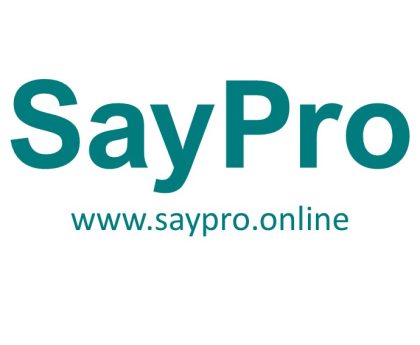SayPro To audit and improve mobile and desktop responsiveness of the SayPro website and sub-portals from SayPro Monthly February SCMR-17 SayPro Quarterly Responsive Design by SayPro Online Marketplace Office under SayPro Marketing Royalty SCMR
Scope: The goal of this plan is to audit and improve the mobile and desktop responsiveness of the SayPro website and its sub-portals. This initiative aligns with the objectives outlined in SayPro Monthly February SCMR-17 and SayPro Quarterly Responsive Design by SayPro Online Marketplace Office under SayPro Marketing Royalty SCMR.
1. Initial Audit and Evaluation of Website Performance
Objective:
The initial audit aims to identify the key issues affecting the website’s mobile and desktop responsiveness. The findings will drive the strategies for improving overall user experience.
Steps to Audit the Website:
- Data Analytics Review:
- Analyze Google Analytics or any other web analytics tool to determine the device breakdown (mobile, tablet, desktop) of website visitors. This helps prioritize areas that need attention, such as mobile-specific issues.
- Review bounce rates and engagement metrics for mobile vs desktop traffic. A high bounce rate on mobile could indicate issues with responsiveness or usability on smaller screens.
- Mobile vs Desktop Performance Assessment:
- Use Google PageSpeed Insights, GTMetrix, or Pingdom to measure the performance scores of both mobile and desktop versions of the website. Focus on metrics such as:
- Page Load Speed: How fast the site loads across various devices.
- Time to First Byte (TTFB) and First Contentful Paint (FCP): Critical performance indicators for user experience.
- Core Web Vitals: These include LCP (Largest Contentful Paint), FID (First Input Delay), and CLS (Cumulative Layout Shift) to assess responsiveness and loading performance.
- Use Google PageSpeed Insights, GTMetrix, or Pingdom to measure the performance scores of both mobile and desktop versions of the website. Focus on metrics such as:
- Responsive Design Check:
- Manually inspect the site on various devices (smartphones, tablets, desktops) to check for design issues such as overlapping content, images not resizing properly, or elements that are hard to interact with on mobile.
- Use developer tools (like Chrome DevTools) to simulate various screen sizes and test responsiveness across different devices.
- Cross-Browser Testing:
- Use tools such as BrowserStack or CrossBrowserTesting to ensure the website works consistently across popular browsers (Chrome, Safari, Firefox, Edge) on both desktop and mobile.
2. Implementing Responsive Web Design Principles
Objective:
To apply web design principles that will ensure the SayPro website provides an optimal user experience across all devices, including mobile and desktop.
Key Strategies for Responsive Design:
- Fluid Grid Layouts:
- Replace fixed-width layouts with fluid grids that use relative units (%,
em,rem) rather than pixel values to allow elements to resize proportionally according to the screen size. - Ensure that the layout adapts smoothly across all screen sizes, from small smartphones to large desktop monitors.
- Replace fixed-width layouts with fluid grids that use relative units (%,
- Media Queries:
- Define specific breakpoints in CSS to tailor the design for different screen sizes. Example of media queries to target different devices: cssCopyEdit
/* Mobile-first styles */ @media screen and (max-width: 767px) { /* Mobile styles */ } @media screen and (min-width: 768px) and (max-width: 1024px) { /* Tablet styles */ } @media screen and (min-width: 1025px) { /* Desktop styles */ } - This approach ensures that the website is mobile-first, prioritizing design for smaller screens and progressively enhancing it for larger screens.
- Define specific breakpoints in CSS to tailor the design for different screen sizes. Example of media queries to target different devices: cssCopyEdit
- Responsive Typography:
- Use relative units like
em,rem, or viewport-based units (vw,vh) instead of fixed pixel sizes for font sizes. This helps ensure that text scales appropriately on different devices. - Adjust line-height, letter-spacing, and text alignment based on screen size to enhance readability across all devices.
- Use relative units like
- Responsive Images:
- Use the
srcsetattribute in image tags to provide different image sizes for various screen resolutions. This ensures that high-resolution images are loaded on high-DPI screens, while smaller images are served on low-DPI screens. - Implement image compression and lazy loading to enhance load times, especially for mobile users with slower connections.
- Use the
3. Mobile Optimization Specific Strategies
Objective:
Ensure that mobile users have an optimal experience when interacting with the SayPro website, considering that mobile traffic is increasingly becoming the dominant method of web browsing.
Mobile Optimization Techniques:
- Mobile Navigation Improvements:
- Implement a hamburger menu or off-canvas navigation to save screen space on mobile devices, ensuring users can easily access key website sections.
- Ensure all menu items are large enough to be tapped comfortably without errors. Test navigation on various mobile devices to ensure ease of use.
- Optimizing Forms for Mobile:
- Form fields should be larger and have sufficient spacing to allow users to easily type on smaller screens.
- Enable input type adjustments (e.g., type=”tel” for phone numbers, type=”email” for email inputs) to trigger the appropriate mobile keyboards.
- Touchscreen Considerations:
- Ensure that all clickable elements are touch-friendly, with a minimum size of 44x44px for buttons and links.
- Optimize interactive elements like sliders, carousels, and modal popups to be fully touch-responsive and functional on mobile.
- Mobile-Specific Features:
- Implement mobile-friendly features, such as simplified layouts, quick load times, and mobile-specific content (e.g., shorter text, easily accessible CTAs).
- Consider adding push notifications for mobile users to engage them effectively.
4. Desktop Optimization Specific Strategies
Objective:
Ensure the desktop version of the SayPro website is fully optimized for a range of screen sizes and resolutions, providing a consistent, feature-rich experience.
Desktop Optimization Techniques:
- Complex Layouts and Elements:
- On desktop, ensure that multi-column layouts and more complex content (e.g., tables, grids, or large media) remain organized and well-aligned.
- Ensure that hover effects, dropdowns, and tooltips function seamlessly across various screen sizes and browsers.
- Optimize for Larger Screens:
- Ensure that content doesn’t appear “stretched” or excessively sparse on larger screens. Implement container width restrictions (e.g., max-width of 1200px) to keep the layout visually balanced.
- Test across a range of desktop screen resolutions to ensure the website adapts appropriately to large HD or 4K displays.
- Desktop Performance Enhancements:
- On desktop, leverage advanced features such as high-definition images, interactive media, and extended content without sacrificing speed or usability.
- Ensure that large images and videos load quickly, especially for desktop users who may expect high-quality media.
5. Testing and Quality Assurance
Objective:
Ensure that all improvements made to the website’s responsiveness are thoroughly tested and validated to guarantee a seamless experience across all devices and browsers.
Key Testing Actions:
- Cross-Browser and Cross-Device Testing:
- Perform extensive testing on various browsers and devices using real devices or simulation tools (e.g., BrowserStack or CrossBrowserTesting). Test across iOS and Android, ensuring compatibility with both Chrome and Safari browsers, as well as various desktop browsers (Chrome, Firefox, Edge, etc.).
- Pay special attention to screen sizes, viewport adjustments, and usability issues that may arise on specific devices.
- Performance Testing:
- Reassess the page speed scores for both mobile and desktop versions after the optimization changes are applied.
- Perform load testing to ensure the website can handle traffic surges without compromising speed or responsiveness.
- User Testing:
- Conduct user experience testing (UX testing) with real users across both mobile and desktop devices. Gather feedback regarding ease of use, navigation flow, and overall satisfaction.
- Implement A/B testing for different layouts or features to determine the best-performing version of the site.
6. Ongoing Monitoring and Maintenance
Objective:
To continuously monitor the performance of the SayPro website and sub-portals after the responsiveness improvements are implemented, ensuring that any issues that arise are promptly addressed.
Key Activities:
- Performance Monitoring:
- Use tools like Google Analytics and Google Search Console to monitor site performance metrics, including mobile and desktop loading times, user engagement, and mobile-specific issues.
- Set up automated testing with tools like Google Lighthouse to track ongoing performance and detect regressions.
- User Feedback and Iteration:
- Continuously collect user feedback, especially for mobile users, through surveys, user testing, or analytics.
- Use this feedback to inform future updates and optimizations.
- Regular Audits:
- Perform quarterly audits to assess new mobile and desktop responsiveness trends, ensuring the site remains current with industry standards and continues to provide optimal performance.
Conclusion
By following this comprehensive approach, SayPro can effectively enhance the mobile and desktop responsiveness of its website and sub-portals. The proposed actions aim to optimize user experience, improve loading times, and ensure the site performs seamlessly across various devices and browsers. This approach aligns with the objectives of SayPro Monthly February SCMR-17 and SayPro Quarterly Responsive Design by SayPro Online Marketplace Office under SayPro Marketing Royalty SCMR, ensuring SayPro stays competitive and user-friendly in the rapidly evolving digital landscape.



